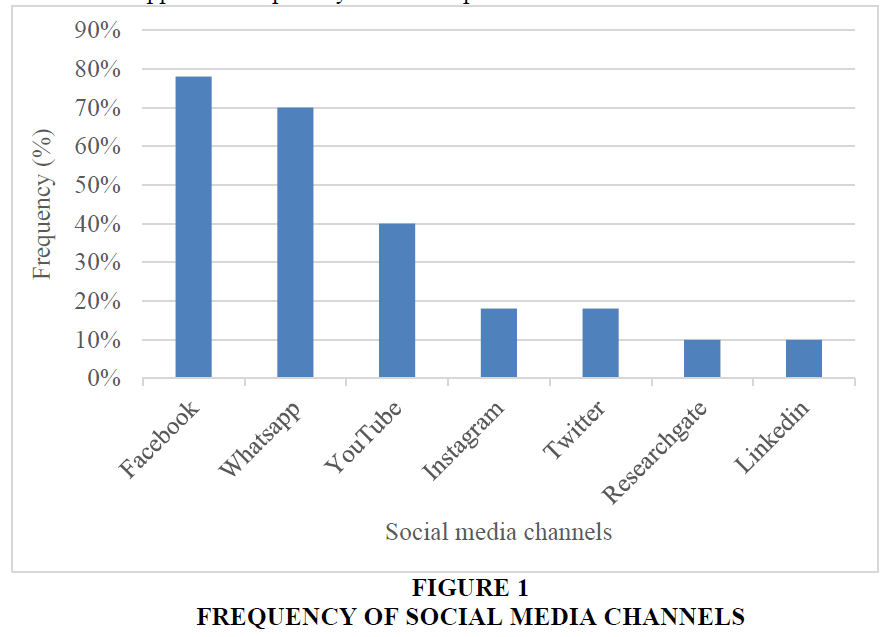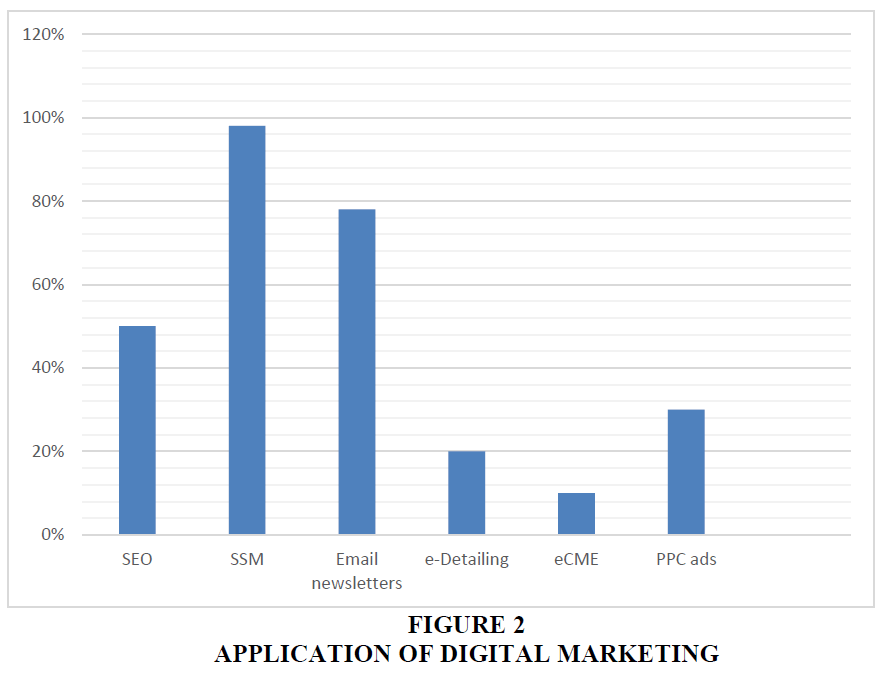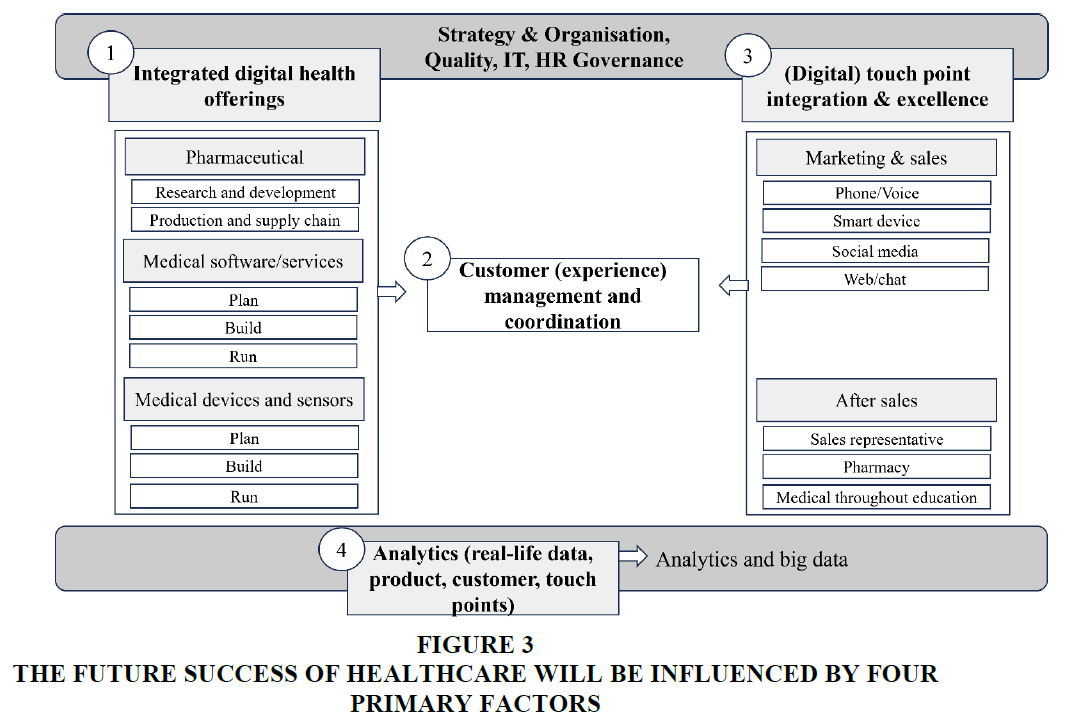Research Article: 2024 Vol: 28 Issue: 4
Healthy Engagement: Digital Marketing's Influence on the Pharma Sector
Rajaprabakaran Rajendran, Jain Deemed-to-be University, Bangalore
Yavana Rani S, Jain-Deemed-to-be University, Bangalore
Citation Information: Rajendran, R., & Rani, Y.S. (2024). Healthy engagement: digital marketing's influence on the pharma sector. Academy of Marketing Studies Journal, 28(4), 1-8.
Abstract
Purpose: The objective of this study to assess and analyse developments and changes in pharmaceutical industry’s approaches to digital marketing. Design/methodology/approach: This article is developed by narrative review method. The authors collected the relevant material from multiple electronic databases using the triangulation method. The results and findings were summarised and synthesised from the selected articles. Findings: Pharmaceutical companies invest over thirty percent of their revenue from sales in marketing in order to maintain and grow their position in the market because they recognise how important it is to use various types of promotional tools to influence physicians' prescription behaviour. The pharmaceutical sector has undergone change as a result of digital technology, and pharmaceutical firms now have new marketing prospects. Pharmaceutical companies' reliance on conventional marketing strategies has diminished and the displacement of face-to-face encounters by the digital marketing strategy in life sciences marketing is promoting digital interactions. Several pharmaceutical companies are adopting to digital marketing, citing the comfort of engagement with clients, the accelerated information-gathering duration, and the cost-effectiveness as reasons for doing so in the current competitive environment. Pharmaceutical companies employ technology-based services to provide physicians with information on their patients' health and the benefits of a particular medicine. Clinicians now find it simpler to discuss specific medical treatments with patients because of digital services. Originality/value: Digital marketing has streamlined mass outreach, organising of awareness campaigns, and advertising at a minimal cost. Physicians can benefit from online medical education programmes in a number of ways, including the quick and affordable learning of new knowledge and skills. According to the studies gathered and evaluated in this paper, pharma digital marketing plays an important role in facilitating personalised care, long-term relationships, and raising company standards, all of which aid in gaining a competitive edge in the global market. Overall, digital marketing practises can aid to acquire new business practises and other types of advantages.
Keywords
Pharmaceutical Marketing, Digital Marketing, Digital Channels, Pharma Digitisation, Pharma Digital Strategies.
Introduction
The pharmaceutical industry is governed by stringent rules that must be complied with. Pharmaceutical companies are not permitted to sell directly to patients the medications that are only allowed to be dispensed by pharmacies and that have been prescribed by physicians. As a result, the pharmaceutical company is unable to directly influence the patients with regard to their products Wick (1898). Since physicians prescribe the medicines to patients, they are the main focus in pharmaceutical marketing rather than the patients. Pharmaceutical companies invest over thirty percent of their revenue from sales in marketing in order to maintain and grow their position in the market because they recognise how important it is to use various types of promotional tools to influence physicians' prescription behaviour Alowi & Kani (2018). Therefore, communication must be 'on time, focused, relevant, reliable, and coherent' which enhances the company's sales performance by reducing the amount of time required to connect with doctors by saving time Kumar & Panigrahi (2014).
The pharmaceutical sector has undergone change as a result of digital technology, and pharmaceutical firms now have new marketing prospects. Pharmaceutical companies' reliance on conventional marketing strategies has diminished and the displacement of face-to-face encounters by the digital marketing strategy in life sciences marketing is promoting digital interactions. The emergence of digital marketing has increased the effectiveness of target group integration on a broad scale without sacrificing the human element Radu et al. (2017).
Methods
This article is developed by narrative review method that follows the IMRAD (Introduction, Methods, Results, and Discussion) format Ferrari (2015), and the authors employed the triangulation method to gather relevant information from numerous sources Wilson (2014). The primary goal of this study was to find earlier and more recently published articles that discussed or were connected to the topic of interest. Four steps were taken to complete the narrative review. The first step was to find all pertinent studies. A number of databases were checked to make sure the majority of the identified articles were appropriate. PubMed, Google Scholar, Science Direct, and JSTOR were among the databases used. Furthermore, the authors used the Google search engine to find related publications.
The next step was the identification of keywords. The authors employed keywords to make it simpler as well as easier for readers to find their work when publishing their findings Demiris et al. (2018). As a result, keywords are crucial while performing searches on databases. The following search terms were incorporated into this article - “marketing AND DIGITAL OR CHANNELS" OR "Pharma digitisation AND physician marketing" OR “pharma digital strategies" AND "pharmaceutical marketing." The subsequent step was to review all the abstracts and articles gathered to ensure that the papers selected were related to this work. Finally, the outcomes and results were compiled and developed from the chosen articles Ferrari (2015).
Results
In the past, paper textbooks, traditional libraries, research journals, and CME programmes were the most common sources for physicians to find new medical information. But in recent years, digital information platforms have changed the search for medical information for doctors with reduced time because of their greater accessibility Haluza et al. (2017). Physicians can benefit from a variety of things from online educational platforms, including the chance to learn new knowledge and skills rapidly and affordably Radu et al. (2017). The development of online technology made it possible for medical practitioners to gather, use, organise, and interact with data more quickly. The use of social media among HCPs has also grown, and it has been discovered to be a successful means of both internal communication and the dissemination of health-related information from pharmaceutical companies Kumar et al. (2021).
Traditional marketing tactics are being replaced by digital marketing in the pharmaceutical sector. This is primarily because there is good end-user communication, engagement takes less time, and it is very cost-effective. Digital marketing has also raised doctors' interest in utilising social media platforms as well as other digital tools. People can converse and exchange information easily because of the widespread use of social media. This impacts the interactions between patients, doctors, and healthcare organisations. The reality that both patients and doctors may easily obtain health information indicates the significance of digital marketing Jawaid & Ahmed (2018).
Pharmaceutical companies utilise technology-based services to inform doctors about the patient's health and the advantages of a particular medicine. Additionally, these digital platforms make it simpler for doctors to converse with patients about specific medical conditions. Mass outreach, campaign planning, and advertising have all been accelerated by digital marketing, all at a low cost Bharskar & Siddheshwar (2020).
Some types of digital marketing channels targeted to physicians
The key channels used by pharmaceutical companies are listed below. Figure 1 depicts the frequency of various social media channels utilised by pharmaceutical companies. Figure 2 shows an application of digital marketing Bharskar & Siddheshwar (2020).
1. Search engine optimization (SEO): When looking for some of the most renowned search engines, people initially go to Yahoo, Google, or Bing. One of the most common Internet activities for users of all ages is searching for health information. Search engines are cited as the most popular method by 47% of internet users for finding services or information. Companies that aren't listed in search engines drastically reduce their chances of connecting with their target market.
2. Pay Per Click Ads (PPC ads): Google may sell advertising if the company's website does not attract enough visitors. Announcements can also be shown on other websites and in a variety of ad networks. depending on the Google search phrases, pay-per-click adverts. Client will assess campaign success rate using analytics tools. The service provider only charges once if anyone clicks the link button.
3. E-mail Newsletters: Email remains consumers' preferred direct channel for regular use in both marketing and customer interactions, as indicated by ExactTarget's 2012 User Preference Survey. However, because of the growing use of smartphones and tablets, customers may access emails with convenience. In fact, 77% of customers prefer to get permission-based promotions via email as compared with text messaging and social media. By using email, customers may choose to engage in a conversation and then only get the information they desire, giving them an impression of control and personalization.
4. Social Media Marketing (SMM): Online search engine platforms utilise social media activities as a marketing tactic. The company benefits from Google+1, Facebook shares, and Twitter retweets in order to appear higher in search engine rankings. Social media marketing enables the organisation to interact directly with its intended audiences. As an outcome, the organisational values are strengthened and the company's reputation is enhanced. Social media use has contributed to modern living, particularly pharmaceutical marketing and the healthcare industry. The majority (97.8%) of research participants were active users of social networks, which is consistent with Moorhead et al.'s definition of the effects of social media development in the United States.
5. e-Detailing: On the Indian e-detailing market, there are incredibly few companies who are active competitors. While the majority of the sales force first viewed e-details with skepticism and questioned whether online promotion could make the conventional sales approach insignificant, they saw the exact opposite result: The quantity of time involved in interacting with the representative is really improved by e-details.
6. Online continuing medical education (eCME): Sessions with a mix of live and online elements are called hybrid meetings. They are also very promising and one of the biggest advancements in event organising. By streaming live video of a conference, event organisers and organising groups may spread visibility of their events. Conference attendees can also benefit from this model. This is considered as the most economical approach adopted by the Indian pharmaceutical sector.
Discussion
The importance of digital marketing in the pharmaceutical business is critical for providing personalised services, care, and building relationships with physicians, which boosts the company reputation and long-term survival. Digital pharmaceutical marketing is a strategic instrument for gaining a competitive advantage over organisations that rely on and adhere to traditional marketing practices. Only through digital marketing will companies be able to communicate with world-class specialists on a global scale.
Particularly, digital marketing helps to increase knowledge about the numerous products that pharmaceutical companies offer, and specialist opinions, product suggestions from users, and user feedback in the form of videos and audios will increase sales for the company. As a result, it is evident that digital marketing may replace traditional marketing in pharma marketing in the future Gupta et al. (2023).
Transformation of the Value Chain
The transformative need must be cascaded down to operations, technology and data requirements, and management competencies in order to develop action plans and specific measures. The requirement to combine organisations, concepts, processes, and technology is a major obstacle to success. As depicted in figure 3, an effective change programme frequently incorporates the following four important factors of the new paradigm to impact the future success of pharmaceutical industry in the digital age Sehlstedt et al. (2016).
1. Integrated services: The entire potential business design and its elements should be defined by merging existing products and business units in order to establish integrated digital health offerings.
2. Managing customer experience: Customer management is a critical factor in transformation initiatives. The strategic components and governance frameworks for a customer focused and digitized pharmaceutical organisation should be defined. It is necessary to create a comprehensive customer experience plan by studying all of the customers (physicians, patients, and payers).
3. Customer-oriented engagements: As essential components for customer-centered use cases, touchpoints and related back-end capabilities must be built and integrated. Touch-point projects, such a new digital sales representative application or online consumer chat, should be defined and prioritised based on the use cases and their requirements. It is also necessary to describe the overarching capabilities for an integrated journey, such as user data, customer relations management as well as information management.
4. Analytics of large-scale data: A digitalized value chain with a customer-centric approach creates new opportunities for learning, assessing success, and enacting change. To support business units in implementing new analytics approaches, it is necessary to create a small, cross-business-unit big data analytics team with technical and consulting capabilities (including data scientists and the supply of a big data cluster). Each business unit should be given specific data analytics duties, such touch-point analytics, which evaluate how well specific contact points are received and how they may be enhanced to encourage rapid learning.
Strategies that have the Potential to be Employed
The following are some strategies that pharmaceutical companies could utilise to boost their chances of succeeding in the digital age Parekh et al. (2016).
1. Collaboration based business model: The pharmaceutical industry is fast evolving due to partnerships with other industries and stakeholders, despite its usual obstacles. The accessibility of digital technologies makes possible for limitless engagement. The research and development of new medications can be carried out by the collaborators in an efficient and effective manner.
2. Business associates: A typical example of a digital strategy is partnering with organisations that oversee complementary aspects of a certain disease. Companies that manufacture anticoagulants for atrial fibrillation, for example, might collaborate with manufacturers of medical devices to identify these people through remote cardiac monitoring. It is simple to implement a digital marketing tool. Instead of simply introducing them, companies should adopt them.
3. Mobile applications: Ahead of leaving the hospital, patients can better understand their diagnoses and treatments by using apps that are delivered in real time through mobile devices. The apps can provide comprehensive medicine details, enabling greater direct to consumer marketing. Pharmaceutical companies would make greater profits if they partnered with businesses that could provide the apps with a focus on patient care, including ailments and medicines, as opposed to sickness management.
4. Data sharing for studies: Huge quantities of data collected over time are typically worthless without adequate analysis. It is important to publish the data-related findings. In the digital age, healthcare will only be really transformed by the integration of point-of-care content, accessibility, and analytics.
5. Develop a new digital marketing organisational structure: To promote innovation in digital marketing and build digital strategies, it would be beneficial to appoint a team of digital marketing experts.
6. Enable Information Technology (IT) assistance: Competent assistance from IT is required in order to solve any digital marketing challenges.
7. Services for Patients and Health Care Providers (HCP): Patients and healthcare professionals (HCPs) anticipate technology-based services from pharmaceutical companies that can help patients in keeping track of their medical conditions as they use more technologies. Furthermore, these services can be very helpful in the development and investigation of novel medicines. Additionally, it integrates participants from the entire healthcare ecosystem to support the administration of care and provide evidence of outcomes. It is important to leverage digital tools for patients, including applications, online platforms, and instructional materials that connect to a variety of services that help patients and HCPs manage their medical conditions.
Conclusion
According to the studies gathered and evaluated in this paper, pharma digital marketing plays an important role in facilitating personalised care, long-term relationships, and raising company standards, all of which aid in gaining a competitive edge in the global market. Overall, digital marketing practises can aid to acquire new business practises and other types of advantages. This research focused on modifications and changes in marketing tactics as a result of the expansion of digital channels in a specific industry (pharmaceuticals). Therefore, the results cannot be extrapolated and applied to other businesses. Future research will be required to explore developments in pharmaceutical marketing.
References
Alowi, M., & Kani, Y.A.M. (2018). Impact of pharmaceutical companies’ promotional tools on physicians’ prescription patterns: a systematic review.
Bharskar, G. R., & Siddheshwar, S. (2020). Digital Marketing In Pharmaceutical Sector. International Journal of Pharmaceutical Science and Health Care, 2(10), 1-7.
Demiris, G., Oliver, D. P., & Washington, K. T. (2018). Behavioral intervention research in hospice and palliative care: Building an evidence base. Academic press.
Ferrari, R. (2015). Writing narrative style literature reviews. Medical writing, 24(4), 230-235.
Indexed at, Google Scholar, Cross Ref
Gupta, P., Raza, K., Mini Agrawal, D. H. B. J., Patil, H., & Somashekhar, I. C. (2023). Antecedents of Pharmaceutical Digital Marketing Challenges and opportunities: A Descriptive Research Design. Journal of Pharmaceutical Negative Results, 1816-1824.
Haluza, D., Naszay, M., Stockinger, A., & Jungwirth, D. (2017). Digital natives versus digital immigrants: influence of online health information seeking on the doctor–patient relationship. Health communication, 32(11), 1342-1349.
Indexed at, Google Scholar, Cross Ref
Jawaid, M., & Ahmed, S. J. (2018). Pharmaceutical digital marketing and its impact on healthcare physicians of Pakistan: a national survey. Cureus, 10(6).
Indexed at, Google Scholar, Cross Ref
Kumar, A., Wadhwa, A., & Amol, G. (2021). Health Care Professionals in the Digital Landscape in India.
Kumar, L., & Panigrahi, C. M. A. (2014). Communication with doctors: empowering Pharma field force with modern marketing techniques. Asian Journal of Management Research, 5(2).
Parekh, D., Kapupara, P., & Shah, K. (2016). Digital pharmaceutical marketing: A review. Research Journal of pharmacy and technology, 9(1), 108-112.
Indexed at, Google Scholar, Cross Ref
Radu, A.V., Tascu, A.V., Stoica, I., Radu, A.C., & Purcarea, V.L. (2017). Online instruments used in pharmaceutical marketing. Farmacia, 65, 317-322.
Sehlstedt, U., Bohlin, N., de Maré, F., & Beetz, R. (2016). Embracing digital health in the pharmaceutical industry. International Journal of Healthcare Management, 9(3), 145-148.
Indexed at, Google Scholar, Cross Ref
Wick, A. (1898). Strategy of multi-channel marketing as a success factor for the pharmaceutical market. Alexander, Wick, Lumbomira Strazovska ISSN, 8431.
Wilson, V. (2014). Research methods: triangulation.
Received: 09-Nov-2023, Manuscript No. AMSJ-23-14146; Editor assigned: 10-Nov-2023, PreQC No. AMSJ-23-14176(PQ); Reviewed: 16-Jan-2024, QC No. AMSJ-23-14176; Revised: 29-Jan-2024, Manuscript No. AMSJ-23-14262(R); Published: 17-May-2024


